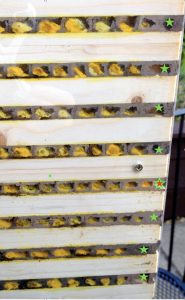What is the vestibular cell in a Red mason bee nest?
In the photograph below you will see all but one cell (red star) has what is called a vestibulum, (pl. vestibuli). This is the outermost cell within a nesting cavity and is usually an empty cell, with no provisions, egg or larvae, directly behind the terminal mud plug, which is generally thicker than other mud cells walls in the nest. Seidelmann states that it probably represents the remaining space of a nesting cavity that is too short for an additional cell. Well in the film you can clearly see the female has not taken any notice of this at all! It is the smallest cell I have seen. He continues that the function of the cell remains unclear, although he does offer several suggestions.

Most Red mason bees have a vestibulum in their brood cells
In their work, Zajdel et al concluded that the making of vestibular cells was probably influenced by unstable environmental conditions and the vestibulum did not protect bee nests from nest parasitoids and kleptoparasites.
Solitary Bees by Ted Benton I highly recommend
Steven Falk’s Field Guide to the Bees of Great Britain and Ireland is a must-have book if you want to ID bees and this extremely useful resource Steven Falk’s Flickr web site which furnishes extra photos and other useful resources to assist with identification.
For more info about wild bees see BWARS
.

Recent Comments